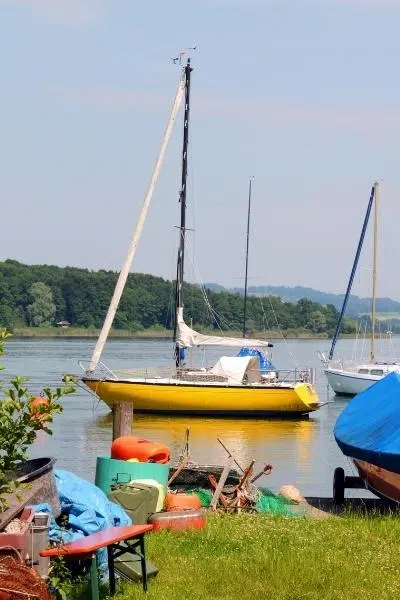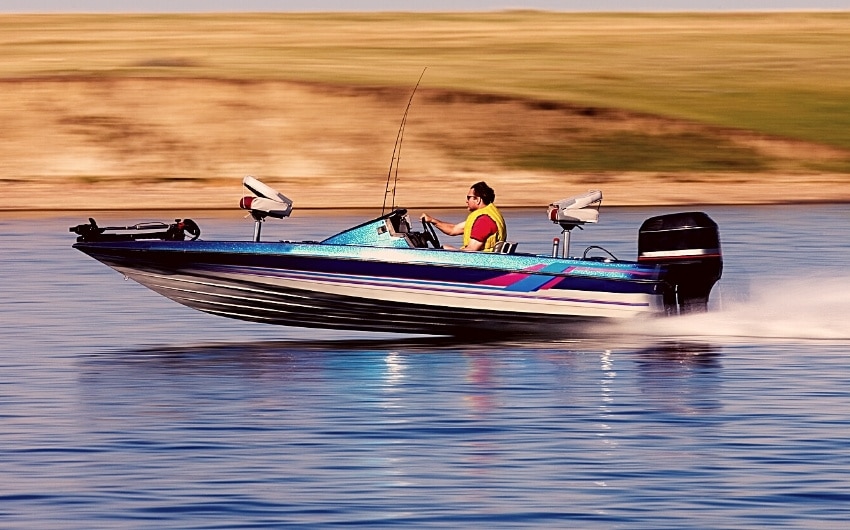Do you want to know How Should You Pass a Fishing Boat? There are many things that every vessel operator must do when passing another boat.
There are many things that every vessel operator must do when passing another boat.
This includes staying in your lane, keeping a safe distance from the other vessel, and following all rules of the road.
We’ll tell you everything you must know about how to pass a fishing boat!
How do you know what to do if you’re a boater and come across a fishing vessel? Do you pass it starboard or port side? What if there are multiple fishing vessels – which go first?
And what about crab pots! Should they be removed before passing by? These are all critical questions that every boater needs to know.

Quick Jump
ToggleHow do you pass a fishing boat?
Steering a fishing boat to pass another vessel on the starboard side means you’ll be going right-hand traffic.
This means that both boats will approach each other from their left sides or ports as seen in front of them when facing forward at sea with no obstacles between your two vessels!
Here’s what you should do when passing a fishing boat that’s on your starboard side:
- Please give them the right of way.
- Ensure you have a clear pathway ahead of you.
- Stay in your lane.
- Keep a safe distance from the other boat.
- Don’t cut in front of them.
- Wait until they have entirely passed before you resume your course.
What side do you pass a boat on the water?
If another ship is approaching you from the port — or left side of your boat, it’s up to the other vessel if they want to cross in front.
But when two powered boats approach one another and only have room for one ship at once (as would be the case with starboard sides),
Whoever was originally going across first has the right-of-way, meaning that person must maintain a safe speed and direction while also keeping speed intact!
Why should go to slow down when passing fish boats?
When two boats cross each other, they should slow down and avoid throwing a large wake on the smaller vessel.
This goes as an act of courtesy to not harm or damage its passage across the water.
Remember, the larger vessel always has the right-of-way!
What if there are multiple fishing boats?
If there are multiple fishing boats, the vessel operator with the right-of-way should move over to allow the other boat attempting to pass.
If both powered boats are approaching from the starboard side, the boat on the right should move over to let the other boat pass.
If both boats are approaching from the port side, the boat on the left should move over to let the other boat pass.
It doesn’t matter if you’re passing one, two, or three fishing boats – the vessel with the right-of-way always moves over!
When should you pass a fishing boat?
When overtaking a fishing vessel, you should pass on the starboard side to avoid a collision.
This means both vessels will steer right or towards their respective sides if they are leaving room for an approaching ship; however it is safe to overlap with them when passing from behind so long as there’s no danger in doing so!
Do you pass on port or starboard?
When two boats meet head-on, they should pass each other port to starboard – or left-right like regular traffic.
So, if you meet another boat head-on: vessels approaching each other are always supposed to pass them port for port or left-handed, just like on the road.
You ought to give them the right of way and ensure you have a clear path ahead before passing. You should stay in your lane and keep a safe distance from the other vessel.
Don’t cut in front of them and wait until they have entirely passed before resuming your course.
What is every vessel operator required to do?
Operators must keep a sharp lookout for any vessels and hazards that may be encountered during their shift.
You should also watch out for other activities involving water, such as radio communications, navigation points, or anything else you might encounter while on patrol in this vital mode of the transportation world.
When traveling in congested waters, it is safe to assume there are others there.
You must be ready for anything at all times while underway.
This includes having a boat in proper operating condition with all boating safety gear being up-to-date and readily accessible at all times!
How should you pass a fishing boat ed?
To pass a fishing boat, you should steer to the starboard side, and they will overtake each other on their right-hand or wrong sides. This way, they will not come in contact with each other.
Both vessels should be traveling at a reduced speed when passing to avoid waking. If possible, the vessel operator with the right-of-way should move over to allow the other boat to pass.
What should you do before letting somebody else operate your PWC?
Before you let someone else operate your watercraft and stand on vessel, be sure to review the following boating safety tips:
- You should always make sure that any person using your vessel knows their responsibilities and operate them safely.
- Before allowing others, be sure they meet the minimum age requirements for boating in your state, as well as have had some sort of primary education about navigation safety rules (such as knowing what slow-no wake means).
- It’s also important you show them where all buttons are on board, so there aren’t uncomfortable surprises when everyone gets busy with tasks at once!
- Lastly, explain why idle speed is critical—it’ll keep people from speeding up too quickly after coming alongside another boat or ship since we want them to stay safe.
What is the upwind side of a fishing boat?
When a boat is sailing in the water, its relative position to other powered boats and ships can change quickly.
Upwind means that you are closer to where their wind blows from (the open sea), while down-the-line or leeward refers specifically to land-based navigation systems like compass points North which may not always be accurate when trying to tell how far ahead another vessel might be through using dead reckoning because they’re relying only on their speed at this point rather than accounting for all up hillsides etc.
What is the cause of almost all fatal boating accidents?
According to the United States Coast Guard, the #1 cause of most fatal boating accidents usually involves someone’s judgment being impaired by alcohol use.
This could be the result of the operator being impaired and passengers on board.
Be sure to have a designated driver and avoid drinking alcohol if you operate a boat.
Other causes of fatal boating accidents include operator inexperience, improper lookout, excessive speed, and machinery failure.
What sides of the channel markers do you stay on?
You must always safely pass on the left-hand side of channel markers.
That way, it ensures there is never any confusion between you and any on-coming vessel operator you might pass with which side is the “passing” side.
If you can’t see what’s coming, it’s always a good idea to sound your horn and make sure everybody is aware of your presence.
What navigation rules must you follow while operating your boat?
The following navigation rules must be followed while operating a boat:
• Boat operators must know the “Rules of the Road.”
• Boats must have flares and a horn on board.
• A vessel radar reflector will ensure your boat is visible even during the daytime.
• All vessels must give way to larger vessels.
• Vessels must use navigation lights when operating between sunset and sunrise.
• Operating a boat whereas impaired by drugs or alcohol is prohibited.
• Children under 16 years old may not control a boat without an adult present.
• Boats must not exceed a speed limit of 25 mph in congested areas.
• Boat operators must use extreme caution when passing on the right.
• Boat operators must sound the horn when approaching and passing other vessels.
• It is illegal to anchor in a traffic lane.
• All persons on a boat must wear a life jacket while the boat is in motion.
What is the right technique for anchoring a boat?
Never tie the boat’s line to a bow cleat to avoid capsizing or swamping.
You should attach it at an angle so as not to add too much weight onto one side when lowering anchors from high above water levels- for this technique to work correctly, there needs to be even distribution across both sides!
Once sufficient rode has been given out by pulling on either yours or someone else’s messenger board (the term used within maritime circles), give them another good solid yank downward before setting off back towards the sea with all possible speed.
The key here is to make sure everything gets pulled equally and be mindful about keeping yourself and others safe and not letting anyone become trapped or get caught up in any lines.
Once anchored, it’s essential to take a moment to sit back and enjoy the beautiful surroundings- make sure to take in all the sights and sounds that’ll be accompanying you for the duration of your stay!
Do fishing boats have the right of way?
The right of way is determined by which direction the boat moves.
When two vessels are traveling in opposite directions, it’s the one on the starboard side with more lines that have priority to pass through an area or enter a port first before any other ships come alongside them.
Suppose you’re unfamiliar with this concept and would like some help understanding why these rules were created. In that case, I recommend reviewing basic marine federal laws as they pertain specifically to your status as a boat operator.
Boaters are expected to know these rules to avoid serious fines and keep themselves safe by taking steps to make sure they don’t end up causing an accident.
Conclusion
Fishing boats are a common sight on the water these days, but how should you pass them? Don’t worry – we’ve got you covered. Passing fishing boats is not as easy as it sounds, and there are many reasons why slowing down or passing to one side could be unsafe. Here’s all that you must know about How Should You Pass a Fishing Boat and safely navigate your boat around other fishers! Be sure to follow these guidelines for safe passage and avoid an accident next time you’re out on the water.
You might also like:

